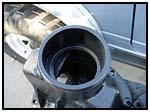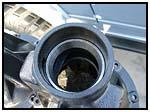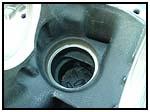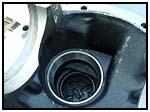4.57 Yukon Gears from Low Range Off-Road
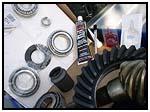 While it is popular to hunt down stock Suzuki gears from Sidekicks and Trackers, there are some good aftermarket gears out there too. We are looking to move the power band a little by installing a set of 4.57:1 gears in each axle to replace the 3.73:1 gears that came in the differentials from the factory. To do this, we needed two new sets of gears and two complete master rebuild kits for the differentials. Low Range Off-Road came through with everything to do the job right.
While it is popular to hunt down stock Suzuki gears from Sidekicks and Trackers, there are some good aftermarket gears out there too. We are looking to move the power band a little by installing a set of 4.57:1 gears in each axle to replace the 3.73:1 gears that came in the differentials from the factory. To do this, we needed two new sets of gears and two complete master rebuild kits for the differentials. Low Range Off-Road came through with everything to do the job right.
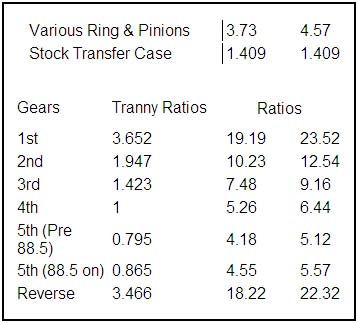 But how did we decide on these gears, and what benefits will they provide? Using the Gear Tables here on iZook.com we gathered all the numbers we needed. We are installing the gears in a 1988.5 Samurai, so we use 0.865:1 ratio for fifth gear in the transmission. We have also moved from a 27″ tire (factory stock) to a 31″ tire. Also, because we are concerned with highway speed in this gear change, we need to use the high range ratio in the transfer case which is 1.409:1. These numbers will not change through the calculations.
But how did we decide on these gears, and what benefits will they provide? Using the Gear Tables here on iZook.com we gathered all the numbers we needed. We are installing the gears in a 1988.5 Samurai, so we use 0.865:1 ratio for fifth gear in the transmission. We have also moved from a 27″ tire (factory stock) to a 31″ tire. Also, because we are concerned with highway speed in this gear change, we need to use the high range ratio in the transfer case which is 1.409:1. These numbers will not change through the calculations.
One thing to remember though, you can make it look like the vehicle can easily run over 100 mph with stock gears and larger tires, but if the engine doesn’t have the power to push the vehicle at those speeds then it is a worthless calculation. These are calculations to start with, then real world testing will tell you if it really works.
 Then we went to the Gear Calculator page and plugged in those numbers to show where we were starting from. We then plugged in the numbers for the new gears to see where we could go. Above you can see that to make seventy miles an hour with stock gears (3.73:1) the engine will be running below the power band. This means that any hill or wind gust will severely effect the speed. The 1.3ltr motor doesn’t really show any power to start to overcome those problems until after the start of the power band (about 3800 rpm). And even then, the steeper the hill or stronger the wind, the more resistance has to be overcome by rpm’s or more torque.
Then we went to the Gear Calculator page and plugged in those numbers to show where we were starting from. We then plugged in the numbers for the new gears to see where we could go. Above you can see that to make seventy miles an hour with stock gears (3.73:1) the engine will be running below the power band. This means that any hill or wind gust will severely effect the speed. The 1.3ltr motor doesn’t really show any power to start to overcome those problems until after the start of the power band (about 3800 rpm). And even then, the steeper the hill or stronger the wind, the more resistance has to be overcome by rpm’s or more torque.  When using the 4.57’s you can see that the engine rpm’s are up into the power band. But do we stop at 70mph?
When using the 4.57’s you can see that the engine rpm’s are up into the power band. But do we stop at 70mph?
Naw…
 As you can see the RPMs are going to be up there, so you better have a fresh engine built to handle the revolutions…
As you can see the RPMs are going to be up there, so you better have a fresh engine built to handle the revolutions… 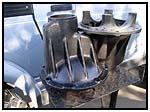 Next we prepped a set of Samurai steel third members. We had the tanked when we did our engine, so they are nice and clean. A fresh coat of paint will keep the rust and corrosion down. Then we install the new bearing races for the pinion. The master kit from Low Range Offroad had all the replacement components you need.
Next we prepped a set of Samurai steel third members. We had the tanked when we did our engine, so they are nice and clean. A fresh coat of paint will keep the rust and corrosion down. Then we install the new bearing races for the pinion. The master kit from Low Range Offroad had all the replacement components you need.
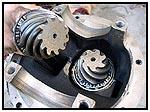
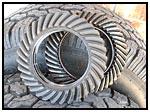 You can definitely see the difference in the pinions. the old pinion has quite a few more teeth. The ring gear also looks a bit different, as there are fewer teeth (although beefier).
You can definitely see the difference in the pinions. the old pinion has quite a few more teeth. The ring gear also looks a bit different, as there are fewer teeth (although beefier). 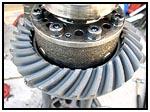
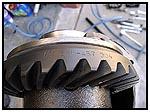 The aftermarket Yukon gears fit nicely. You don’t need a conversion can and spacer when using these. You can also verify the ratio by reading the specs stamped into the ring gear. he gears come with a great instruction book from Yukon that shows how to set the backlash.
The aftermarket Yukon gears fit nicely. You don’t need a conversion can and spacer when using these. You can also verify the ratio by reading the specs stamped into the ring gear. he gears come with a great instruction book from Yukon that shows how to set the backlash. 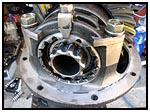
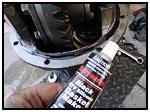
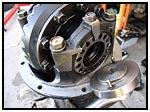 The picture on the left will look a little different from your carrier. This is a locking flange for the KAM electric locker we have in the rear of the Stalker. The opposite side can be adjusted as usual and when everything is ready to go in we used the RTV that came with the kit.
The picture on the left will look a little different from your carrier. This is a locking flange for the KAM electric locker we have in the rear of the Stalker. The opposite side can be adjusted as usual and when everything is ready to go in we used the RTV that came with the kit. 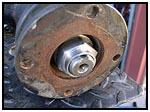
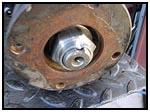 After getting the backlash correct, this is probably the most important part of the gear installation (don’t ask how I know). There is a reason why there is a sleeve end on the nut, and a cut in the pinion. If you don’t ‘stake’ the nut, it will leave you under high vibration. Don’t be ‘That Guy’ on the trail. Bottom line: Aftermarket gears aren’t much different to install than stock gears, and you can customize your performance with more options than just the stock ratios. Work the numbers and find out what YOU need for your application. Source:
After getting the backlash correct, this is probably the most important part of the gear installation (don’t ask how I know). There is a reason why there is a sleeve end on the nut, and a cut in the pinion. If you don’t ‘stake’ the nut, it will leave you under high vibration. Don’t be ‘That Guy’ on the trail. Bottom line: Aftermarket gears aren’t much different to install than stock gears, and you can customize your performance with more options than just the stock ratios. Work the numbers and find out what YOU need for your application. Source:
Low Range Off-Road, LC 529 N 2740 W Provo, UT 84601 tel (801) 805-6644 fax (801) 805-8188
sales@lowrangeoffroad.com tech@lowrangeoffroad.com
Regular Business Hours Monday – Friday, 9:00am – 5:00pm Mountain Time Saturday, 12:30pm – 5:00pm Mountain Time
08/11/10 15:08:02
[tech/footer.htm]

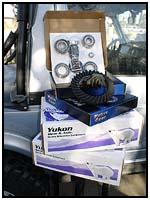
 with Bill Johnston
with Bill Johnston